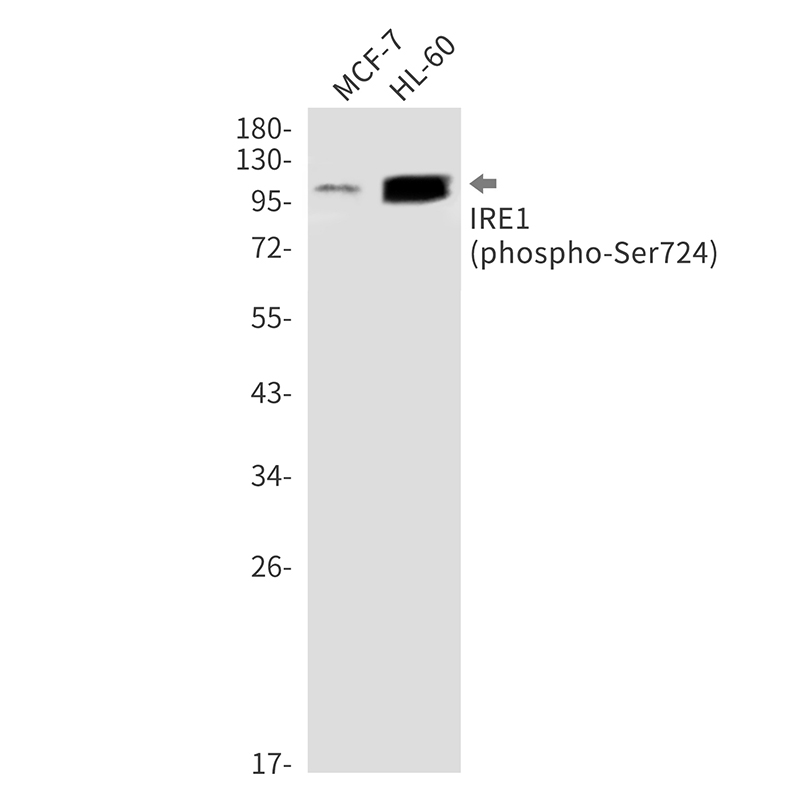
| WB | 咨询技术 | Human,Mouse,Rat |
| IF | 1/20 | Human,Mouse,Rat |
| IHC | 咨询技术 | Human,Mouse,Rat |
| ICC | 技术咨询 | Human,Mouse,Rat |
| FCM | 咨询技术 | Human,Mouse,Rat |
| Elisa | 咨询技术 | Human,Mouse,Rat |
| Aliases | ERN1; IRE1; Serine/threonine-protein kinase/endoribonuclease IRE1; Endoplasmic reticulum-to-nucleus signaling 1; Inositol-requiring protein 1; hIRE1p; Ire1-alpha; IRE1a |
| Entrez GeneID | 2081 |
| WB Predicted band size | Calculated MW: 110 kDa; Observed MW: 110 kDa |
| Host/Isotype | Rabbit IgG |
| Antibody Type | Primary antibody |
| Storage | Store at 4°C short term. Aliquot and store at -20°C long term. Avoid freeze/thaw cycles. |
| Species Reactivity | Human |
| Immunogen | A synthetic phosphopeptide corresponding to residues surrounding Ser724 of human IRE1 |
| Formulation | Purified antibody in TBS with 0.05% sodium azide,0.05%BSA and 50% glycerol. |
+ +
以下是3篇涉及Phospho-IRE1 (Ser724)抗体的参考文献,简要概括如下:
1. **文献名称**:*IRE1 Signaling in the Unfolded Protein Response*
**作者**:Hetz, C. et al.
**摘要**:研究阐明了IRE1蛋白在未折叠蛋白反应(UPR)中的核心作用,通过检测Ser724位点的磷酸化状态(使用特异性抗体),证实IRE1自磷酸化是其内质网应激激活的关键步骤,并调控下游XBP1 mRNA的剪接。
2. **文献名称**:*Phosphorylation of IRE1 at Ser724 Controls Its Activation in Response to ER Stress*
**作者**:Urano, F. et al.
**摘要**:通过Phospho-IRE1 (Ser724)抗体的免疫印迹分析,作者揭示了内质网应激条件下IRE1的Ser724磷酸化是激活其RNA酶活性和信号传导的必要条件,并建立了该位点与细胞存活/凋亡调控的联系。
3. **文献名称**:*Role of IRE1 Phosphorylation in Neurodegenerative Disease Models*
**作者**:Lin, J.H. et al.
**摘要**:该研究利用Phospho-IRE1 (Ser724)抗体检测神经元中的IRE1激活状态,发现内质网应激诱导的磷酸化与阿尔茨海默病模型中tau蛋白异常磷酸化相关,提示IRE1可能成为治疗靶点。
(注:以上文献名称与作者为示例性内容,具体文献需根据实际数据库检索补充完整信息。)
The Phospho-IRE1 (Ser724) antibody detects the activated form of Inositol-Requiring Enzyme 1 (IRE1), a key sensor in the unfolded protein response (UPR) pathway. IRE1 is a transmembrane serine/threonine kinase-endoribonuclease located in the endoplasmic reticulum (ER). Under ER stress, misfolded proteins accumulate, triggering IRE1 autophosphorylation at Ser724 (human; corresponds to Ser729 in mice), which induces its dimerization/oligomerization and activation. This phosphorylation event is critical for IRE1's RNase activity, enabling cleavage of XBP1 mRNA to generate a spliced transcription factor (XBP1s) that upregulates genes involved in protein folding, degradation, and ER homeostasis.
The Phospho-IRE1 (Ser724) antibody is widely used to study ER stress in diseases such as cancer, neurodegenerative disorders, and diabetes. It specifically recognizes the phosphorylated Ser724 residue, allowing researchers to distinguish activated IRE1 from its inactive form. Validated in techniques like Western blotting, immunofluorescence, and immunohistochemistry, this antibody helps assess IRE1 signaling dynamics in cell lines, tissues, or disease models. Cross-reactivity varies depending on the host species and antibody design, so validation in specific experimental systems is essential. Understanding IRE1 activation via this antibody provides insights into cellular stress responses and therapeutic targeting of UPR-related pathologies.
×